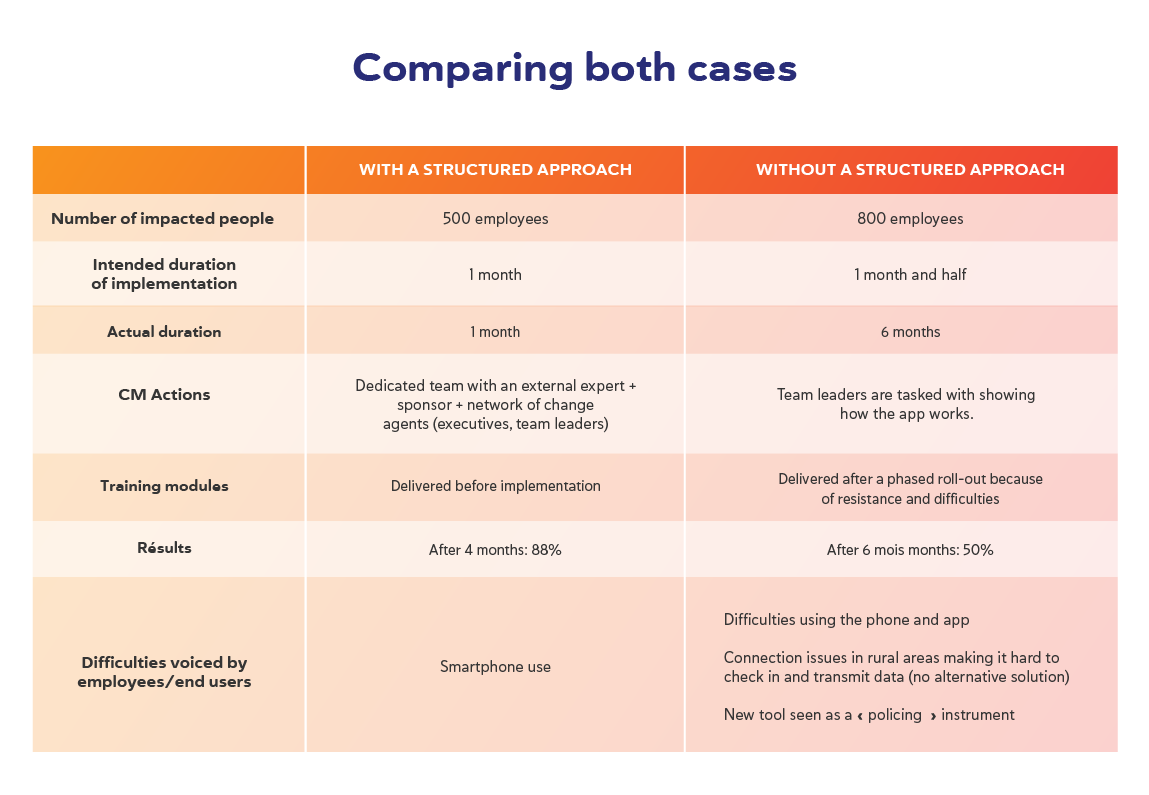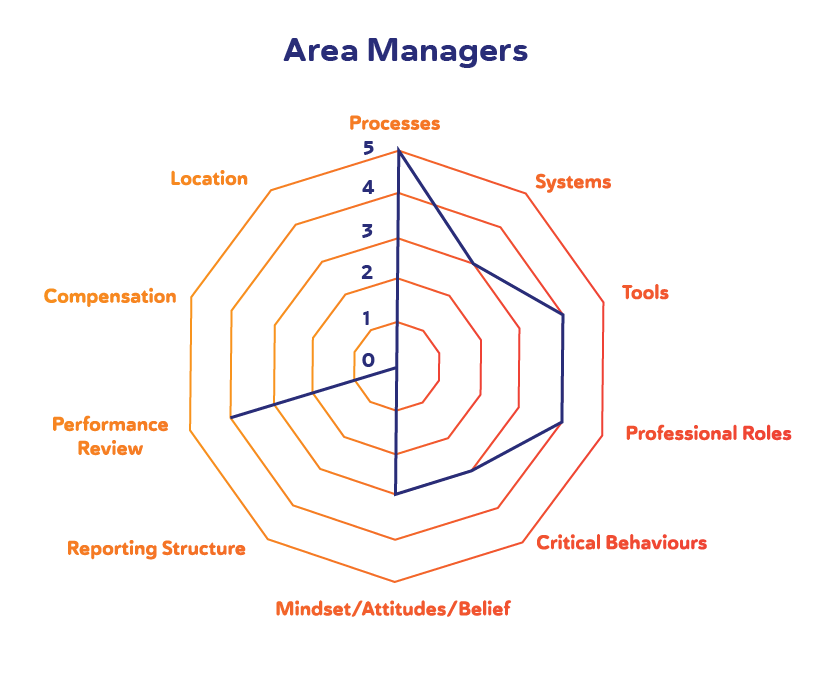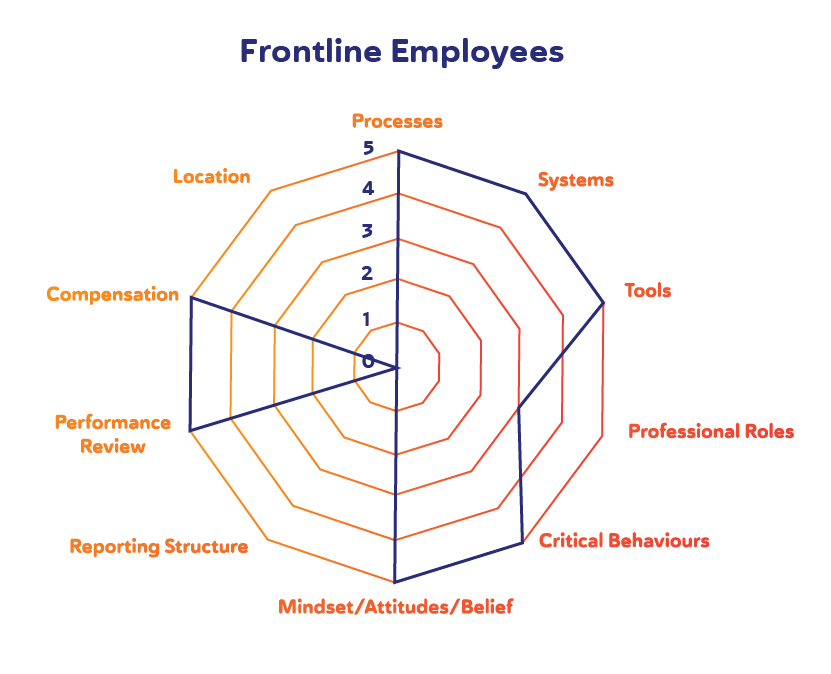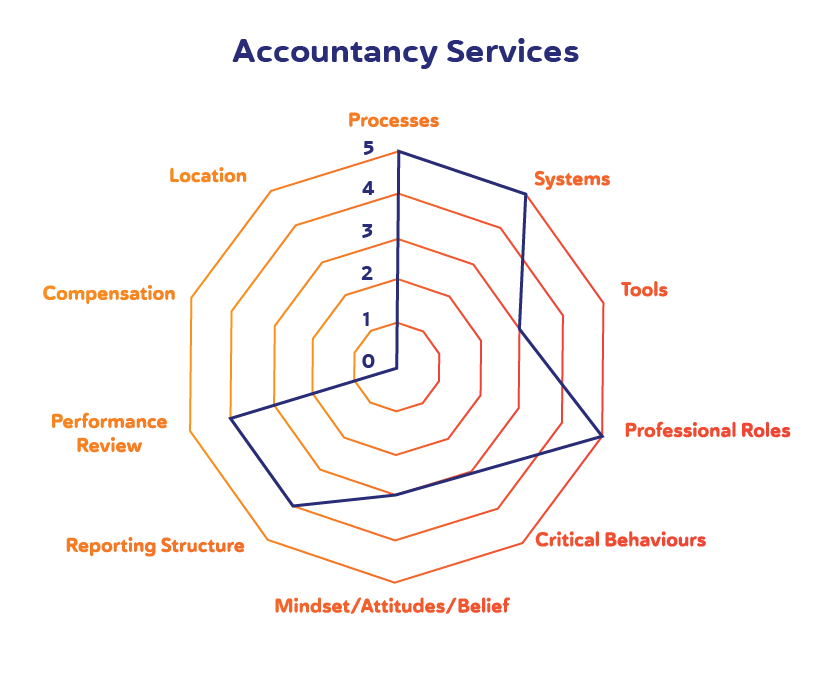Change Management: Results With and Without. A Case Study.
22 February 2022
Same change, same time, two different approaches, widely different outcomes.
Article written by Nelly Tire and Vincent Piedboeuf
22 February 2022
Same change, same time, two different approaches, widely different outcomes.
Article written by Nelly Tire and Vincent Piedboeuf
Prosci Europe's case studies offer practical insights for organisations wishing to make changes that stick.
Why should I read? To get a real-life example of what can happen without a structured approach to managing the change. We uncover the difference in outcome between two organisations seeking to deploy the same technological solution to a recurrent and common issue in the personal care service sector.
Highlights:
Year – 2021.
Sector – Personal Care Services.
Who – Two non-profit organisations offering social services such as childcare, home nursing, special assistance to vulnerable people, heavy-duty housework, etc.
What – In a nutshell, outdated paper-based management and monitoring systems generate errors, poor responsiveness, and late payments while also causing the organisations and the sector to miss out on new opportunities. The new "Mobile Teleprocessing System" attempts to leverage technology to optimise the provision of existing and future services.
Type of change – See below.
Baseline. Managing and controlling provided services happens through a two-fold mechanism of phone check-in used by staff members in the home of users (elderly, physically- challenged people, etc.) and paper-form shift sheets subsequently signed by users (date of the month, number of hours).
Internal reasons to change. Both entities sought to provide practical solutions to recurrent problems reported by frontline employees/account services. Climbing on the train of digitisation was also expected to raise the sector's attractiveness. More specifically, both associations faced the following issues:
External reasons to change. The availability of game-changing technological solutions, which could also respond to concerns related to funding, turned the change into a pressing issue. The mix of specific requirements and opportunities included:
This set of external and internal drivers led to "Mobile Teleprocessing" project. The overarching element of the action plan was the switch from the aforementioned "point system" (fixed phone system and shift sheets) to the use of a particular app running on a professional smartphone and connected in real-time with the all-in-one software for planning/accountancy. This advanced solution could also help manage instant alerts in case of a change in the internal working schedule. Sending off invoices would be just one click away. Other apps responding to specific health and care issues were also under consideration.
Expected benefits ranged from shortening processing times and reducing errors when logging data to improving communication with frontline employees and funders.
Highlight: The first organisation implemented the solution within one month, impacting 500 employees. The plan was based upon Prosci's best practices and ADKAR model for individual change. Here is an overview of the main items:
Active and visible sponsorship throughout the whole duration of the project is the number-one success factor of any change initiative. In this case, the Director-General was designated as the primary sponsor. Beyond its involvement in the early phases, he was provided with data fresh from the field to remind people of the rules and communicate results.
The association allocated resources to CM, setting up a dedicated team with a change practitioner and a network of change agents.
The organisation identified the groups impacted by the change (frontline employees, team leaders, accounting services) to prepare targeted training sessions.
Before moving any further along the change journey, the association communicated extensively around the project and the strategic reasons underpinning it. They proceeded to:
After completing the impact analysis and conducting preliminary campaigns to raise awareness and desire, the organisation started to prepare the people for the change. They did so by:
To ensure long-lasting results and effective use of the phone and app, the association proceeded to:
Highlight: The size of the change was even more significant in the second case, impacting about 800 employees. The expected time for completion was one month and a half. But unlike its counterpart, this association did not implement any structured Change Management plan. Team leaders viewed the technical solution as an easy fix.
Items: Team leaders were tasked with demonstrating how the application worked, with the following consequences:
Clear differences in outcomes show the importance of adopting a structured approach to managing the change. The implementation lasted one month without any significant setback in the first case. Not only did this association meet the deadline. Adoption and utilisation rates after four months were close to 88%. In contrast, implementation suffered from major delays in the second case. While leaders had planned on a one-month and a half roll-out, deployment was only complete after six months. Moreover, adoption and utilisation rates proved grossly insufficient, with a more modest 50%.

If all the above-described Change Management items account for what did go well in the first case, what went wrong in the second one?
A common mistake is to jump right into equipping the people without raising Awareness and creating Desire. This second case study clearly illustrates the consequences of not laying the foundations for the change. Omitting this part led to early resistances, crystallizing without any strategy or capacity to mitigate them. The new system was seen as a policing maneuver of sorts.
Furthermore, there was no attempt to create engaging training materials, leaving team leaders without a clear roadmap or tools to deliver Knowledge. Frontline employees lamented the lack of information or guidance. Issues with the phone connection in some rural regions also meant that employees were unable (Ability) to use the solution. The new system, first seen as a quick fix, created distrust, and with nothing being done, the snowball effect sat in.
Change cannot be left to chance.
Check out our resources to learn more about Change Management and stay updated!
PROSCI's impact analysis provides a very accurate overview of the kind of change involved. The following "radar graphs" identify how the project "Mobile Teleprocessing" affects the three main target groups: Area Managers, Domestic Helpers, and Accounting Services. Most dimensions are self-explanatory[1], but let's point out that processes, systems, tools, and critical behaviours – heavily emphasised in this case study – refer to:



[1] PROSCI's change impact model offers a robust framework to define the change along 10 dimensions that may impact people involved. These dimensions or areas typically include Processes (1), Systems (2), Tools (3), Professional Roles (4), Critical Behaviours (5), Mindset/Attitudes/Belief (6), Reporting Structure (7), Performance Review (8), Compensation (9), Location (10). To learn more: https://www.prosci.com/resources/articles/defining-change-impact
![]()
Nelly Tire is a PROSCI certified change manager and an independent consultant. She has supported many public and private organisations, in France and abroad (Australia, United-Kingdom) through their transformations, with one objective: supporting individuals throughout the change while helping organisations achieve their goals.
After having managed a large number of changes in a wide range of business sectors, Vincent Piedboeuf dedicates his time helping managers to optimise their return on investment through effective integration of the people side in their change projects. He is one of the most active Change Management instructors and certifies hundreds of people in Prosci methodology every year.
